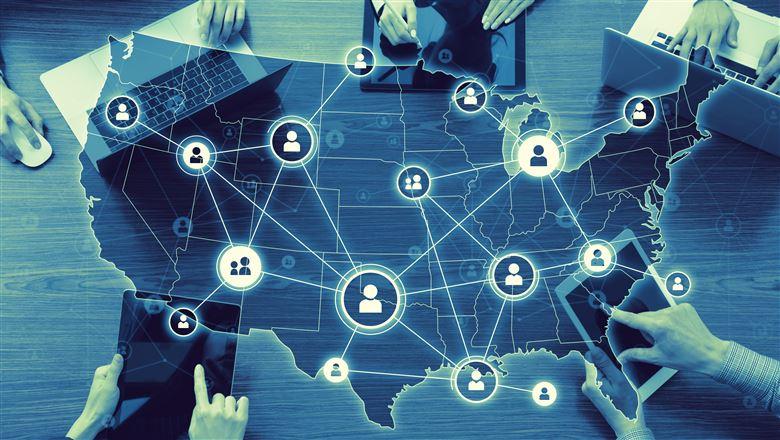In today’s dynamic landscape where technology is reshaping the traditional workspace, remote work is no longer a perk but a necessity. Amidst this transformation, how does employment law catch up? Is the law agile enough to accommodate the fluidity and flexibility that the digital age demands?
Remote Work in the Digital Age
In the whirlwind of technological advancement and globalization, the concept of remote work has burgeoned into a prominent aspect of professional life. The integration of high-speed internet, collaborative software, and sophisticated mobile devices has rendered geographical boundaries almost irrelevant. We’re living in an era where work is defined not by where it’s done but by what is accomplished.
Imagine a world where the grueling commute is replaced by an amble to the coffee machine, where office attire is a concept of the past, and the traditional office, a reminiscence. This isn’t a utopian fantasy but a reality for millions across the globe. Remote work in the digital age offers an unrivaled degree of flexibility, enabling professionals to design their work schedules around their optimum productivity periods, rather than adhering to the conventional nine-to-five work paradigm.
But with this newfound freedom come challenges and opportunities. Companies are venturing into uncharted territories, where the physical office is a virtual space, and team meetings are convened on digital platforms. Remote work is reshaping organizational culture, demanding a revamp of strategies aligned with on-site operations. Employers are fostering environments that advocate for autonomy, trust, and open communication, cornerstones that uphold the edifice of remote working.
As individuals and organizations wade through these waters, certain challenges rear their heads. The blurring lines between work and personal life, the potential for professional isolation, and the quest for preserving organizational culture are facets that are constantly under scrutiny. Moreover, the question of productivity, often a matter of concern for employers, is now viewed through the lens of outputs rather than hours spent in an office.
The intersectionality between technology, employee well-being, and organizational efficiency is most evident in the realm of remote work. There’s a democratization of work happening – opportunities are sprawling beyond city limits, casting a wider net of talent, diversity, and skills. In this landscape, innovation is not just welcomed; it’s required.
Despite the alluring flexibility, the digital divide is still a significant hurdle. Not everyone has equal access to the high-speed internet and advanced technology that makes remote work feasible. Addressing this disparity is not just a corporate responsibility but a societal imperative to ensure that the digital age doesn’t leave anyone behind.
In navigating through the intricacies of remote work in the digital age, there’s a distinct realization that our approach to work, the place we assign it in our lives, and how we integrate it with our personal existence is undergoing a transformation. It’s a shift that’s not just changing where we work but how we perceive work, measure productivity, and define professional success.
The journey through the digital transformation of work isn’t linear. It’s a multifaceted evolution characterized by innovations, setbacks, and learning. In the quest to align professional aspirations with personal well-being, remote work emerges not as a transient trend but a pivotal component of the future of work. In this epoch, adaptability, resilience, and innovation aren’t just corporate jargons but essentials carving paths through the digital wilderness of the modern professional landscape.
Employment Law Considerations
The enigmatic dance between remote work and employment law is as intricate as it is essential. With the seismic shift towards virtual workspaces, the legal frameworks that govern employment need to be as agile and adaptable as the digital landscapes they seek to regulate. We’re at a juncture where the traditional constructs of employment law are being stress-tested by the dynamic, fluid nature of remote work.
When addressing remote work, a plethora of legal aspects comes to the forefront. Key among these are the rights and responsibilities of both employers and employees. The virtual workspace is not immune to the legal obligations traditionally associated with physical workplaces. Work hours, overtime, rest breaks, and vacations – these elementary components of employment are refracted through a new lens in the context of remote work.
One significant concern is the tracking and management of work hours. In a conventional office setting, an employee’s presence and working hours are relatively straightforward to monitor. However, the flexibility inherent in remote work muddles these waters. How do employers ensure compliance with legal standards for work hours and overtime in an environment where employees might be working unconventional hours across diverse time zones?
Health and safety regulations represent another intricate piece of the puzzle. Traditionally, these have been anchored in the physical workplace, but the shift to home offices and co-working spaces necessitates a reevaluation of how these laws apply and are enforced. The onus is not just on the employers to ensure a safe working environment but also on remote employees to adhere to safety protocols within their diverse work settings.
Privacy and data security are also pivotal. In a digital workspace, the boundaries between personal and professional data can often be porous. Employers need to implement robust security protocols to safeguard sensitive information, whilst also respecting the privacy of remote workers. This delicate balance is not just a technological challenge but a legal one, demanding a nuanced approach to policy formulation and enforcement.
Discrimination and equality laws continue to hold their ground firmly, even in the virtual workspace. Every employee, irrespective of their geographical location or the nature of their work, is entitled to a workplace free from discrimination and harassment. Upholding these rights in a remote setting requires vigilance, education, and a commitment to fostering an inclusive, respectful virtual work culture.
As we plunge deeper into the digital age, it becomes increasingly evident that the intersection between employment law and remote work is neither static nor defined. It’s a dynamic space, evolving in tandem with technological innovations, organizational needs, and employee expectations. In this unfolding narrative, the adaptability and responsiveness of legal frameworks are not just desirable but indispensable.
Navigating this complex, multifaceted landscape requires a synergy between legal acumen, technological prowess, and human insight. It’s not just about creating laws that govern remote work but about fostering a legal ecosystem that is as dynamic, inclusive, and forward-looking as the digital age itself. The roadmap to this destination is charted not just with legal ink but with the collective aspirations of a workforce stepping boldly into a future where work is not a place you go, but a thing you do.
Adaptation of Companies
In the complex tapestry of the digital age, companies are not just participants but active weavers, intricately threading their operational, cultural, and strategic adaptations to fit into the burgeoning landscape of remote work. As virtual environments become mainstream, organizations are compelled to reimagine not just where work happens, but how it’s executed, evaluated, and optimized.
Imagine an organization where spatial boundaries dissipate, where collaboration is not confined to meeting rooms but is a digital orchestration of talents, ideas, and innovations. This isn’t a futuristic abstraction, but a contemporary reality. Companies, from tech giants to nimble startups, are shifting gears, leveraging technology and innovative management practices to facilitate effective remote work.
But adaptation isn’t a switch to be flipped; it’s a journey, punctuated with learning, unlearning, and relearning. Companies are honing in on technology as the linchpin. Investment in sophisticated, secure, and user-friendly digital platforms is skyrocketing. These aren’t just tools but conduits for collaboration, innovation, and engagement, bridging the physical divide with digital connectivity.
Yet, technology alone isn’t the panacea. The human element, pulsating at the core of every organization, is coming under the spotlight. Management practices are evolving, metamorphosing from oversight to empowerment. Trust, autonomy, and accountability are the new watchwords. Leaders are learning to manage by objectives and outcomes, replacing the traditional yardsticks of time and presence.
As companies skate this complex terrain, organizational culture is emerging as both a challenge and a catalyst. How do you preserve the ethos, values, and identity of a company when physical interactions are minimal or non-existent? Innovative solutions are emerging – virtual team buildings, digital onboarding, online knowledge sharing sessions, and virtual social engagements. Culture is being untethered from physical spaces, crafted and nurtured in the virtual ecosystems where interactions, learning, and collaboration blossom.
In the legal parlance, companies are navigating the intricate corridors of compliance, rights, and responsibilities. Adaptation is not just about enabling remote work but ensuring it’s anchored in legal and ethical frameworks. Companies are crafting policies and protocols addressing data privacy, employee rights, health, and safety, not as bureaucratic necessities but strategic imperatives.
A pivotal revelation in this journey is the realization that adaptation isn’t a one-size-fits-all proposition. It’s as diverse as the workforce it seeks to empower. Customization, flexibility, and inclusivity are emerging as cornerstones. Companies are crafting remote work paradigms that acknowledge and celebrate the diversity of needs, preferences, and potentials of a global, diverse workforce.
In this grand odyssey of adaptation, learning is iterative, and evolution is constant. Companies are not just adapting to remote work; they are actively shaping its contours, injecting it with innovations, insights, and humanism. In this narrative, every virtual meeting, every digital collaboration, every policy crafted, and every technology adopted, is a stitch in the intricate tapestry of a future where work is untethered, yet connected; virtual, yet profoundly human.
In essence, the adaptation of companies to remote work is a dynamic dance, a rhythmic oscillation between technology, human ingenuity, and legal frameworks, crafting a symphony where work transcends physical boundaries, yet is deeply rooted in organizational culture, ethical principles, and human connection.
Future Trends
As we cast our gaze forward, peering into the horizons of the future of work, it’s evident that the intertwining forces of technology, human adaptability, and regulatory landscapes are not just shaping but actively crafting the narratives of tomorrow. In this evolving orchestration, remote work isn’t a temporary dalliance but a fundamental shift, heralding an era where flexibility, technology, and human-centric approaches are the norm rather than the exception.
Visualize a world where artificial intelligence, machine learning, and advanced analytics are not just enablers but core constituents of the workplace. In this future, the conception of productivity is decoupled from time and space – it’s an intricate blend of outcomes, value, and impact. The digital platforms that facilitate this transformation are becoming increasingly sophisticated, integrating features that cater not just to functional efficiency but human wellness, collaboration, and innovation.
In this unfolding narrative, the role of physical office spaces is undergoing a metamorphosis. The future is not necessarily about the annihilation of physical workplaces but their reimagining. Hybrid work models are emerging, where offices are innovation hubs, collaboration spaces, and cultural epicenters, while the flexibility of remote work is seamlessly integrated into the organizational fabric.
Yet, amidst this exciting evolution, the human element pulsates at the core. Employee wellness, mental health, and work-life harmony are not peripheral but central themes. Organizations are crafting policies, protocols, and cultures that are profoundly human-centric. Technology is a facilitator, ensuring that while work is virtual, human connections, collaborations, and engagements are real, tangible, and meaningful.
In the regulatory landscape, agility is the watchword. Employment laws, regulations, and policies are evolving to be as dynamic, flexible, and adaptable as the digital workplaces they seek to govern. In this future, the legal frameworks are not just responsive but anticipatory, crafted with the foresight to accommodate innovations, disruptions, and transformations that characterize the digital age.
In this projection into the future, one trend is unequivocally clear – learning and adaptability are not just valued but essential. Skills are the new currency, and lifelong learning is the pathway. Organizations are fostering environments where learning is continuous, opportunities for skill enhancement are ubiquitous, and adaptability is ingrained in the organizational DNA.
As we navigate this future, diversity and inclusion emerge as powerful themes. Remote work is democratizing opportunities, ensuring that talent is recognized, nurtured, and leveraged, unrestricted by geographical, cultural, or physical boundaries. In this world, diversity is not just celebrated but is a fundamental driver of innovation, creativity, and organizational excellence.
Yet, this journey into the future isn’t without its challenges. Cybersecurity, data privacy, and ethical considerations are paramount. As work becomes increasingly digital, protecting sensitive information, safeguarding privacy, and ensuring ethical use of technology are imperatives that will command attention, investment, and innovation.
In general, as we oscillate on the brink of tomorrow, the future of remote work is unveiling itself as a symphony of technology, human ingenuity, regulatory foresight, and organizational adaptability. It’s a world where boundaries are fluid, opportunities are democratized, and the human spirit is not just acknowledged but celebrated in the intricate dance of productivity, innovation, and wellness in the digital age.
Employee Well-being and Productivity
In the dynamic ensemble of the digital workforce, employee well-being and productivity emerge as two sides of the same coin. The correlation between a worker’s mental, emotional, and physical health and their output quality is not just acknowledged but profoundly influential in shaping organizational policies, cultures, and strategies in the realm of remote work.
Envision an ecosystem where employee well-being isn’t an add-on but the foundation upon which organizational structures, cultures, and operations are built. In the remote work environment, the physical separation of teams doesn’t equate to emotional and psychological isolation. Companies are innovating, utilizing technology to not only facilitate task completion but foster connections, community, and camaraderie.
The digital platforms are evolving, integrating features that cater to the holistic well-being of remote workers. Think of virtual lounges for casual interactions, digital wellness modules integrated into work platforms, and AI-driven analytics providing insights into employee wellness and engagement levels. In this space, technology is not just a conduit for task completion but a bridge fostering human connections.
Productivity, in this dynamic, is being redefined. It’s not a linear function of hours clocked but a more intricate weave of value delivered, innovation fostered, and impacts made. Remote work is breaking down the walls of rigid time structures, heralding an era where flexibility, autonomy, and outcomes are the focal points. Employees are empowered to craft their schedules, aligning work with their peak productivity periods and personal commitments.
However, this beautiful orchestration of well-being and productivity isn’t without its challenges. The blurring boundaries between professional and personal lives, the potential for overwork and the omnipresent digital connections can sometimes tip the scales towards stress and burnout. Companies are cognizant of these challenges and are actively crafting strategies to mitigate them.
Work-life harmony emerges as a powerful theme. It’s about integrating work and personal life in a manner that fosters wellness and productivity. Companies are instituting policies that encourage downtime, disconnects, and recuperation. The emphasis is on holistic wellness – physical, mental, emotional, and social.
Training and development programs are evolving to include modules on mental health, stress management, and digital wellness. Leaders are being equipped with skills to recognize and address wellness challenges within their teams, fostering an environment where well-being is not just individual but collective.
In the legal and ethical realms, the focus on employee well-being is mirrored in evolving regulations and policies. Legislations are becoming more nuanced, recognizing the unique challenges and opportunities presented by remote work. Employers are tasked with ensuring not just the physical safety but the mental and emotional well-being of their remote workforce.
As we navigate this intricate landscape, a profound realization takes center stage – employee well-being is not a static, one-dimensional construct. It’s dynamic, multifaceted, and deeply intertwined with organizational cultures, operational paradigms, and technological ecosystems. In the world of remote work, well-being and productivity are not just correlated but symbiotic, each feeding into and enriching the other, shaping a future where work is not just something you do but an integral, harmonious part of who you are.
Legal Challenges
The emergence of remote work as a prominent mode of professional engagement has ushered in a complex, intricate matrix of legal challenges. Organizations, regulatory bodies, and employees are navigating an unprecedented landscape, where the traditional paradigms of employment law are being recalibrated to fit the nuanced, dynamic contours of virtual workplaces.
At the forefront of this evolution is the matter of compliance. How do organizations ensure that the rights and responsibilities traditionally anchored in physical workspaces are seamlessly translated into the virtual realm? This question isn’t rhetorical but profoundly operational, demanding meticulous attention to detail, adaptability, and foresight.
One of the pivotal legal challenges is delineating and managing work hours. In a world unbound by the traditional 9-5 structure, tracking, managing, and compensating for work hours becomes a complex endeavor. Overtime, rest breaks, and off-hours – these fundamental elements are undergoing a redefinition. Companies are tasked with ensuring that flexibility doesn’t morph into exploitation or overlook the fundamental rights of employees to rest and recuperation.
Furthermore, the issue of health and safety is undergoing a profound metamorphosis. In the absence of physical oversight, ensuring that employees’ work environments meet the requisite safety standards is a challenge. Employers are innovating, leveraging technology to facilitate virtual assessments, employee self-audits, and digital reporting of workspace safety parameters.
In the realm of data security and privacy, the challenges are magnified. The digital nature of remote work amplifies the potential for breaches, unauthorized access, and cyber threats. Organizations are tasked with implementing robust, agile cybersecurity protocols to safeguard sensitive data. Moreover, the intersection of personal and professional digital ecosystems poses challenges to privacy. Legal frameworks are evolving to address these intricate issues, balancing organizational security with individual privacy rights.
The legal challenges aren’t restricted to operational elements but permeate the cultural and interpersonal realms of remote work. How do laws addressing discrimination, harassment, and workplace equity translate in a virtual environment? The legal systems are adapting to ensure that the principles of fairness, respect, and equality are upheld, even when employees are dispersed across geographical boundaries.
Moreover, international remote work adds another layer of complexity. Employees working in different countries or states bring into play a multifaceted legal landscape of varying employment laws, tax regulations, and compliance requirements. Companies are not just managing diverse teams but are navigating an intricate matrix of legal obligations, each nuanced by regional, national, and international statutes.
As we plunge deeper into this complex legal tapestry, a realization emerges – the need for legal frameworks that are as dynamic, adaptable, and forward-looking as the digital landscapes they govern. Traditional legal paradigms, anchored in the physicality of workplaces, are undergoing a transformation. The focus is shifting towards creating laws and regulations that are responsive to the fluid, dynamic nature of remote work.
Organizations are responding by instilling legal agility into their operational, strategic, and cultural fabrics. Legal compliance is not viewed as a bureaucratic necessity but a strategic imperative. Companies are investing in legal expertise, technology, and training to ensure that as they navigate the dynamic waters of remote work, legal compliance, and ethical integrity are unwavering.
In essence, the legal challenges of remote work are unveiling an opportunity – to create legal, ethical, and operational paradigms that are not just responsive but anticipatory. In a world where work is defined by outcomes rather than location, and flexibility is a cornerstone, legal systems are evolving to become enablers rather than gatekeepers.
As we gaze into the future, the legal challenges of remote work are not hurdles but stepping stones, each unveiling opportunities to create workplaces that are not just compliant but are epitomes of fairness, respect, security, and innovation. In this narrative, every legal challenge is a thread weaving the intricate tapestry of a future where work, well-being, legal integrity, and innovation coalesce into a harmonious, dynamic symphony.
Benefits and Downsides
The oscillation between the benefits and downsides of remote work is a dance as intricate as it is revealing. On the one hand, we are witnessing a liberation from the confinements of traditional office spaces and rigid schedules. On the other, we grapple with the challenges of blurred work-life boundaries and the potential isolation that can emanate from virtual workspaces. Each benefit and downside is a thread weaving the complex tapestry of the new normal in the professional landscape.
Benefits
- Flexibility is often hailed as the most significant boon of remote work. The ability to design one’s work schedule, the elimination of commuting, and the option to work from anywhere have empowered employees with a level of autonomy unheard of in traditional employment settings. This flexibility is not just a logistical convenience but a profound influencer of employee well-being, work-life harmony, and productivity.
- Diversity and Inclusion have found fertile ground in remote work environments. Companies are no longer constrained by geographical boundaries in talent acquisition. This global reach has facilitated a rich diversity in teams, bringing together a melange of skills, perspectives, and innovations that are the bedrock of organizational creativity and excellence.
- Cost Savings for both employers and employees are significant. Companies save on overhead costs associated with physical office spaces, while employees save on commuting and related expenses. This financial efficiency is translating into investments in technology, employee well-being, and organizational development.
Downsides
However, this rosy picture is not without its thorns. Isolation and Loneliness are emerging as significant challenges. The absence of physical interactions, the camaraderie of team members, and the organic interactions that define physical workplaces can lead to a sense of isolation. Companies are innovating to mitigate this, but the challenge is persistent and profound.
- Work-Life Balance is another intricate dance. The flexibility of remote work, while a boon, can also lead to blurred boundaries between professional and personal lives. The ‘always-on’ digital culture can lead to overwork, stress, and burnout. Balancing flexibility with boundaries is an ongoing challenge.
- Cybersecurity is a heightened concern in virtual work environments. The dispersion of employees across various locations, each connected digitally, amplifies the risk of cyber threats, data breaches, and privacy concerns. Companies are bolstering their cybersecurity protocols, but the challenges are evolving as swiftly as the solutions.
In this intricate dance between the benefits and downsides of remote work, a nuanced perspective emerges. Each benefit is not just an opportunity but a catalyst for innovation, adaptation, and growth. Each downside is not a hurdle but an instigator of solutions, strategies, and evolutions that are shaping the future of work.
In this narrative, the intersectionality between technology, human ingenuity, and organizational adaptability is most palpable. As we navigate through the benefits, we are propelled into a world where work is not confined but liberated, not rigid but fluid, not isolating but inclusive. As we address the downsides, each challenge unveils pathways to innovations, policies, and cultural shifts that are not just reactive but anticipatory.
In essence, the dance between the benefits and downsides of remote work is choreographing a future that is as dynamic as it is unpredictable, as challenging as it is rewarding, and as innovative as it is foundational. In this landscape, every benefit and downside is a stroke painting a future where work, well-being, innovation, and human connection coalesce into a narrative as profound as it is transformative.
Technological Advancements
In the nuanced dance of remote work, technological advancements are the rhythm, setting the pace, amplitude, and trajectory of this evolution. We’re not just witnesses but active participants in a period of profound digital transformation. Each innovation, each new piece of technology, isn’t just a tool but a building block, constructing the edifice of the future of work where boundaries are fluid, opportunities are democratized, and productivity is redefined.
One cannot overlook the pervasive influence of AI and machine learning. These aren’t abstract concepts relegated to tech discussions but tangible, impactful realities shaping the remote work landscape. AI is enhancing efficiency, automating repetitive tasks, and offering predictive analytics to steer strategic decision-making. Machine learning algorithms are the silent observers, learners, and implementers, personalizing employee experiences, and optimizing work processes.
Collaborative tools and platforms are the unsung heroes of the remote work revolution. These digital platforms are the bridges, connecting geographically dispersed teams, facilitating real-time collaboration, and nurturing the ethos of organizational culture in virtual spaces. But their role isn’t static. They are evolving, integrating functionalities that cater to not just professional but personal well-being. Virtual coffee lounges, digital mental health pods, and AI-driven wellness reminders are becoming mainstream.
In the security domain, blockchain is making waves. In a world where data is gold, its security is paramount. Blockchain is emerging as a robust, reliable solution, ensuring data integrity, security, and privacy. The decentralized, immutable nature of blockchain technology is a bulwark against data breaches and unauthorized access, a critical ally in the complex landscape of remote work.
Let’s also traverse into the world of virtual and augmented reality (VR and AR). These technologies are transcending gaming and entertainment, marking their indelible imprint on professional landscapes. Virtual meetings spaces, augmented reality project collaborations, and immersive training modules – these aren’t futuristic concepts but present-day realities, amplifying the depth, engagement, and efficacy of remote work.
Yet, these technological advancements are not without their intricacies. With digital integration comes the paramount issue of cybersecurity. As workspaces become increasingly virtual, the vulnerability to cyber threats, data breaches, and privacy violations escalate. Companies are countering this with sophisticated, agile cybersecurity protocols, AI-driven threat detection systems, and continuous employee training to navigate the digital landscape securely.
The role of technology in employee well-being is another narrative unfolding. The digital fatigue, the ‘always-on’ culture, and the blurred boundaries between professional and personal lives are real challenges. Technology is both a protagonist and an ally here. Digital detox apps, AI-driven mental health assistants, and virtual wellness modules are emerging as counterforces, ensuring that technology is a facilitator of well-being, not a detractor.
In essence, the technological advancements shaping remote work are as dynamic as they are transformative. They are catalysts, propelling organizations, and employees into an era where work is not defined by location but by outcomes, not by time but by value, and not by presence but by impact. As we navigate this intricate journey, every piece of technology, every innovation is a thread weaving the intricate tapestry of a future where work, well-being, innovation, and human connection coalesce into a narrative profound, dynamic, and replete with possibilities yet unimagined.
Conclusion
As we weave through the intricate dance of remote work, technological advancements, legal landscapes, and the human element, a narrative of transformation, adaptability, and innovation emerges. The journey unveils a future where work isn’t confined by walls but is as boundless as our innovation. It’s a world marked by flexibility, inclusivity, and a harmonious integration of professional aspirations and personal well-being. Every challenge encountered is a stepping stone towards unprecedented solutions, painting a future where the digital and human elements coalesce, not in conflict but in a symphony of seamless integration, each enriching, elevating, and evolving the other.
FAQs
Q1: How are companies ensuring the continuous professional development of remote employees?
A1: Companies are leveraging online learning platforms and virtual workshops to ensure continuous learning and development. Customized e-learning modules, virtual mentorship programs, and online certifications are being employed to foster skill enhancement and professional growth, irrespective of the employees’ geographical locations.
Q2: How is the onboarding process adapted for remote employees?
A2: Digital onboarding processes have been introduced, featuring virtual orientations, online training modules, and e-welcome kits. New hires can meet team members through virtual meet-and-greets and are provided with digital resources to integrate seamlessly into the company culture and workflow.
Q3: Are there specific insurance policies tailored for remote workers?
A3: Yes, insurers are evolving to offer policies that cater to the unique needs and risks associated with remote work. These include enhanced health and wellness coverage, cyber security insurance, and policies covering ergonomic home office equipment to ensure a safe and productive work environment.
Q4: How do remote workers stay updated with the company’s evolving policies and protocols?
A4: Companies use digital communication platforms to keep remote employees informed. Regular virtual meetings, digital bulletins, and cloud-based document sharing ensure that every team member has real-time access to updated policies, guidelines, and protocols.
Q5: How is employee engagement measured in a remote work setting?
A5: Engagement is gauged through digital surveys, virtual feedback sessions, and data analytics that assess employee participation, productivity, and overall satisfaction. Metrics like virtual attendance, project completion rates, and participation in online company events also offer insights into the engagement levels of remote staff.







